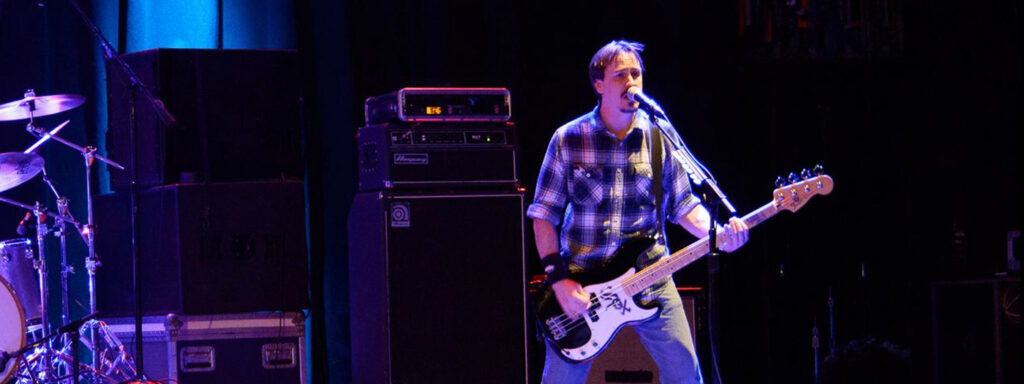The Ultra Lo
NEWS
“Bass Discovered Me” – Ryan Manna
By: Dino Monoxelos

Photography by Rik Kirby
One of the many things I absolutely love about my job—and, of course, the bass community—is that, for the most part, we’re all the same people. What I mean by that is, if you look at the life journey of, say, twenty different bass players from all different genres and styles, you’ll see that our life journeys are all very similar: how we pursued playing music, how we ended up playing bass—in most situations is very similar.
On top of that, our job as a bass player in most situations is also very similar: to support the song!
Of course, there are exceptions to these rules. There are many virtuosic players that go way beyond breaking this mold and create something that is unique to only them. They push the boundaries of what “traditional” bass playing looks like. But when you talk to them about their journey coming up, we’re back to finding that we’re all the same people.
It doesn’t matter what style of music we play either. I think that’s why the bass playing community is so accepting of our own—of all styles, levels, ages, and genders. Maybe that’s also why bass players often make great producers… or why producers make such great bass players, maybe. We’re usually the bond that brings together rhythm and harmony—the foundations of being, well… people, I guess.
So, this brings me to my point here about us all being the same, and why I love my job. I’ve been fortunate enough to meet literally hundreds, if not thousands, of bass players from around the globe—and possibly beyond (I actually think someone once said they were from Mars). A lot of whom, through the beauty of social media (yes… you can find some beautiful uses of social media if you look for it), have kept in touch over the years. And many I consider friends to this day.
This latest project of celebrating Ampeg’s 75th Anniversary continues to amaze me and introduces me to players and producers who’ve been fans and users of Ampeg over the years—people I might not have otherwise met. Thanks to our good friend Mr. Daniel Liston Keller from “Get It In Writing” and his long list of friends and colleagues (players, producers, engineers, techs, etc…), he’s not only introduced them to me and me to them, but he’s also captured their thoughts and the essence of what Ampeg means to them and their role in creating music.
So, with all this being said, let me introduce you to Ryan Manna. Ryan is, again like I said, very much one of us. And like a lot of us, yes, we “discovered” the bass—but more in reality, the bass discovered him, like it did all of us. Especially when he got his first Ampeg, an SVT-7PRO, and discovered how simple it is to get a great bass tone without having to “twiddle” a bunch of knobs, as he says. Ryan talks about his journey with his band Unit 287 and how Ampeg has become a big part of his sound and his creative process within the band. If you listen to his story—not just from a bass player’s perspective but as anyone who’s been in a band and has been playing all these years—you’ll find his journey is very similar to any one of ours. Yes… the bass discovered us, but the music found us first! Hey Ryan… thank you for being a part of the Ampeg story, and here’s to another 75 years!!!

Dino has spent over 25 years in the Ampeg world conducting seminars and clinics all over the globe. He’s also the author of four instructional bass books by Mel Bay and his own publishing company, MonoTunes Music. His favorite bass to play is his MTD 534-24.
NEWS
Does Size Really Matter

By: Dino Monoxelos
I know this topic has been around the block more times than a NYC taxicab but I’m gonna give it one more go here.
So this topic recently came up on a Facebook users group called Bass Amplifiers Only. And I do believe it’s a great topic to be discussed. Not debated or scrutinized, just discussed. So grab your favorite beverage and snack and lets discuss.
It all comes down to what tool will work best for the job right? And more importantly, which tool(s) will inspire you to play and create the very best version of YOU!
Someone had mentioned how they use (another brand’s) 1×15″ combo amp and regardless of the size of the room, if you’re using a good DI or being mic’d, that’s all you’ll ever need. I feel while this is true in a “get the job” done sorta way, there are so many variables here that we should consider we might not be able to address them all in one blog or even cover in a conversation, but hopefully this blog gives some things to think about.
From a somewhat scientific approach, BAO’s moderator and founder, Hod Meehan, a gentleman whose technical knowledge and real-world use of this stuff surpasses most electrical and audio engineers I know, had this to say regarding sympathetic vibrations and the relation between large format amps and the instrument itself:

“Size matters significantly when you are using a microphone or DI and a cabinet capable of low B and a long throw aperture. A cabinet with let’s say, a JBL E-140’s will strongly interact with the body of the bass guitar, causing it to sympathetically resonate at several frequencies along the neck of a properly built instrument. And when you put a sextet of big power and preamp tubes on top of it, the harmonic richness is infinitely superior to any small amplifier not interacting with the physical resonance of the bass itself. It’s this interaction that takes a bass guitar sound from a simple bass sound to a physical resonant experience received by the skeleton of the listener.”
While I can’t comment about sympathetic vibrations, I can comment about that last sentence regarding the “skeleton of the listener”, namely… ME and my bandmates. It’s how “I” feel when I have my favorite amp behind me on stage. Either a V-4B or an SVT through either a 212 cab or an 810. Again, it all depends on a bunch of variables… the size of the stage, the venue, the load-in (if I’m the one lugging the gear), the other musicians I’m playing with and what they’re bringing to the gig, am I going through the PA and who’s running it? IEMs or not, it’s not always about being loud or being the loudest person on stage. Again, it’s all about how I feel, and how that vibration coming in from behind makes ME interact with how I’m playing. And to bring it even one step further, how it makes the people I’m playing with feel and interact with me. I’ve done plenty of IEM only gigs. And I know, in some cases they’re a necessity in today’s world. But make no mistake, I’ve yet to work with a drummer who hasn’t said… “man, I miss having a bass amp right beside me kicking me in the a**” on some of those ampless gigs.
Now, could I get away with doing some of these bigger gigs with a smaller combo amp? Yeah probably. Do the laws of diminishing returns apply? Yep… they do. In fact, in many cases, once you get into the “enormodome” or stadium-size arenas, a big amp becomes less and less important. Unless we harken back to the days of sub-standard PA systems where you would need a literal wall of 810 cabs on your side of the stage, most bass rigs just can’t cover a stadium-sized stage as well as a modern-day PA, especially if you’re on IEMs. But let’s face it, most of those gigs are far and very few between for most of us.
Most of what I’m talking about here are venues that range in size from your local sports bar down the street to medium to large festival style stages.
For me personally, this is why I have several different rigs. Yes I know, I’m lucky enough to work for an amp company that supports my amplifier addiction, but even before I worked for Ampeg I always had a selection of amps for different jobs on hand.
At the end of the day, it comes down to YOUR personal preference and like I said earlier, what brings out the best performance from YOU. Just be reasonable about your expectations and the gig you’re playing. I would no sooner bring an entire SVT stack to a coffee house gig, any quicker than I’d bring a small Rocket Bass combo to an outside festival sized stage. Again, the latter depending on who I’m playing with whether its loud rock trio or a quiet folk gig. And trust me, there have been plenty of gigs where I realized I may have under OR over-estimated the gig and the size of amp I brought. Hence why sometimes, I’ll actually bring both. (Yes… I have an over-infatuation about having the right rig on hand… Hey, its my job to be that way! LOL) That’s why Ampeg pretty much has an amp in every size and power rating for every situation. And it’s also why I can help other players decide on which amp would suit them best… Because I’ve played them all.
Anyways, play what makes you feel good, play what inspires you to play more, and most important of all… HAVE THE MOST FUN DOING IT!!!
Until next time… Play more bass!

Dino has spent over 25 years in the Ampeg world conducting seminars and clinics all over the globe. He’s also the author of four instructional bass books by Mel Bay and his own publishing company, MonoTunes Music. His favorite bass to play is his MTD 534-24.
